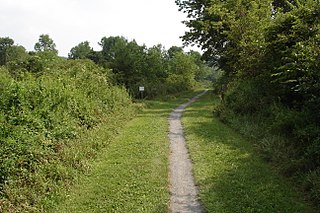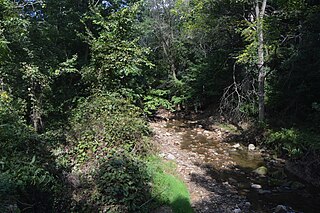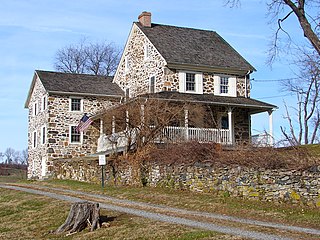
Greenville is a borough with home rule status in northwestern Mercer County, Pennsylvania, United States. Located along the Shenango River, it lies roughly 80 miles from both Pittsburgh and Cleveland. It is 1.89 square miles in area, and had a population of 5,541 as of the 2020 census.

Sharon is a city in western Mercer County, Pennsylvania, United States. The city, located along the banks of the Shenango River on the state border with Ohio, is about 15 miles (24 km) northeast of Youngstown, about 65 miles (105 km) southeast of Cleveland and about 60 miles (97 km) northwest of Pittsburgh. The population was 13,147 at the 2020 census. It is part of the Hermitage micropolitan area.

The Allegheny Portage Railroad was the first railroad constructed through the Allegheny Mountains in central Pennsylvania. It operated from 1834 to 1854 as the first transportation infrastructure through the gaps of the Allegheny that connected the midwest to the eastern seaboard across the barrier range of the Allegheny Front. Approximately 36 miles (58 km) long overall, both ends connected to the Pennsylvania Canal, and the system was primarily used as a portage railway, hauling river boats and barges over the divide between the Ohio and the Susquehanna Rivers. Today, the remains of the railroad are preserved within the Allegheny Portage Railroad National Historic Site operated by the National Park Service.

Jacobsburg Environmental Education Center is a 1,168-acre (473 ha) Pennsylvania state park near Wind Gap, in Bushkill Township, Northampton County in Pennsylvania. The Jacobsburg National Historic District is almost entirely surrounded by the park. Jacobsburg Environmental Education Center is just off the Belfast exit of Pennsylvania Route 33.

The Beaver and Erie Canal, also known as the Erie Extension Canal, was part of the Pennsylvania Canal system and consisted of three sections: the Beaver Division, the Shenango Division, and the Conneaut Division. The canal ran 136 miles (219 km) north–south near the western edge of the state from the Ohio River to Lake Erie through Beaver County, Lawrence County, Mercer County, Crawford County, and Erie County, Pennsylvania.

Beallsville Historic District is a 40-acre (16 ha) district in Beallsville, Pennsylvania. It is designated as a historic district by the Washington County History & Landmarks Foundation.

Etna Furnace, also known as Mount Etna Furnace, Aetna Furnace, and Aetna Iron Works, is a historic iron furnace complex and national historic district located at Catharine Township, Blair County, Pennsylvania. The district includes five contributing buildings, six contributing sites, and two contributing structures. It encompasses a community developed around an iron furnace starting in 1805. Included in the district is the four-sided stone furnace (1808), gristmill site, canal locks, site of lock keeper's house, aqueduct, two small houses, the ruins of a charcoal house (1808), the foundation of a tally house, a blacksmith shop, bank barn, foundation of a boarding house, three family tenant houses, two iron master mansions, a store and paymaster's office, Methodist / Episcopal Church (1860), and cemetery with graves dating between 1832 and 1859.

Curtin Village, also known as Eagle Ironworks, is a national historic district located in Boggs Township, Centre County, Pennsylvania. The district includes eighteen contributing buildings and three contributing structures in Curtin.

Fort Hunter Historic District is a national historic district located at Fort Hunter, Dauphin County, Pennsylvania. The district includes six contributing buildings, four contributing sites, and one contributing structure. The area has seen continuous settlement since the early 1700s and once was the site of an early supply fort and garrison. Also in the district are the remains of a section of the Pennsylvania Canal. Notable buildings include the separately listed Archibald McAllister House, a spring house, Everhart Covered Bridge, large frame barn (1876), corn crib, farm house, blacksmith shop, stone stable barn, Hunter's House or Old Hotel, ice house, and archaeological sites for Fort Hunter, the garrison, Hunter's Mill, and the Pennsylvania Canal.

The Newville Historic District is a national historic district which is located in Newville, Cumberland County, Pennsylvania. The district is bordered roughly by Cove Alley, Big Spring Creek, the right-of-way for the Cumberland Valley Railroad, and Washington Street, and encompasses 414 contributing buildings, one contributing site, and two contributing objects in the central business district and surrounding residential areas of Newville.

Chickies Historic District is a national historic district located at East Donegal Township, West Hempfield Township, and Marietta, Lancaster County, Pennsylvania, United States. The district includes 32 contributing buildings, 16 contributing sites, and four contributing structures in three areas. They are: 1) floodplain along the Susquehanna River containing archaeological remains of iron furnaces; 2) the "Ironmasters' Hill" area of Marietta with five residences associated with ironmasters ; and 3) the Donegal Creek area with farmland, iron pits, and limestone quarries owned by the ironmasters.

The Stoddartsville Historic District is a national historic district that is located in Buck Township, Luzerne County, Pennsylvania.

The New Hamburg Historical Area is a national historic district located at Delaware Township, Mercer County, Pennsylvania.

The Tulpehocken Creek Historic District is a national historic district located in North Heidelberg Township, and Lower Heidelberg Township, Berks County, Pennsylvania. Encompassing a total of 17,000 acres, this district stretches from the Tulpehocken Creek and Mill Creek at the Berks County-Lebanon County line to the Blue March Dam between Bernville and Millardsville, and is composed of 152 contributing buildings, one contributing site, and four contributing structures which were related to the development which occurred along the upper Tulpehocken Creek from the early 18th century through the late 19th century. Historic buildings located here include early settlement period log cabins, which were built between 1723 and 1750; buildings related to the Charming Forge community, which existed between 1749 and 1895; an early 18th century cemetery and early 19th century church; buildings related to 18th and 19th century farming operations; and structures associated with the development and operation of the Union Canal.

Brownsburg Village Historic District is a national historic district located at Brownsburg, Upper Makefield Township, Bucks County, Pennsylvania. The district includes 37 contributing buildings, 1 contributing site, and 2 contributing structures in the village of Brownsburg. Most of the buildings were built between 1810 and 1840, and reflective of the Italianate and Federal styles. The oldest building is the Beaumont Tavern House and tenement. Other notable buildings are the Grace Johnson House, Gilbert Tenement, Andrew Jamison House, and Slack Bungalow. Also in the district are structures related to the site of the Delaware Division of the Pennsylvania Canal.

Okehocking Historic District, also known as the Okehocking Indian Land Grant Historic District, is a national historic district in Willistown Township, Chester County, Pennsylvania. It was listed on the National Register of Historic Places in 1993.

The Hopewell Farm, also known as Lower Farm and Hopedell Farm, is a historic home and farm located at 1751 Valley Road in Valley Township, Chester County, Pennsylvania. The 500-acre farm complex has six contributing buildings, one contributing site, and six contributing structures. The buildings and property were added to the National Register of Historic Places in 2010.

The Reading Furnace Historic District is a national historic district that is located in Warwick Township and East Nantmeal Township, Chester County, Pennsylvania.

The North Warwick Historic and Archeological District is a national historic district that is located in Warwick Township, Chester County, Pennsylvania.

Prizer's Mill Complex is a national historic district located in East Pikeland Township, Chester County, Pennsylvania. The district includes 5 contributing buildings, 1 contributing site, and 2 contributing structures. They include miller's houses dated to the 18th and 19th century, two barns, a cistern, a grist mill, millrace, and the remains of a 19th-century carriage house.
























